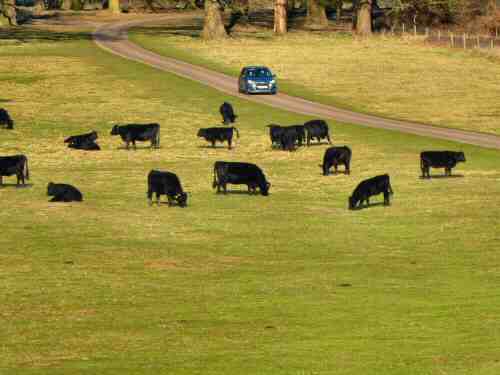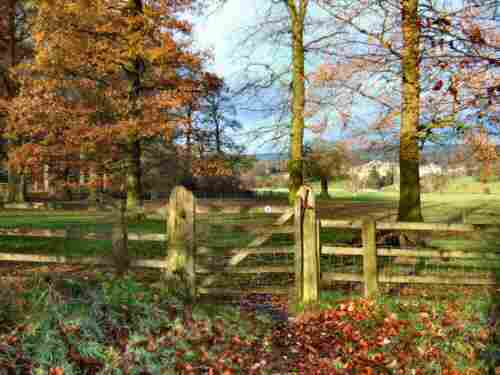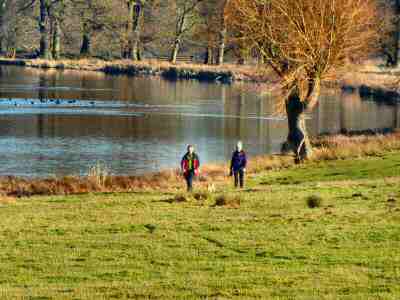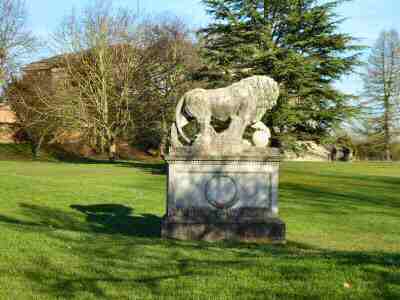KEDLESTON

INFORMATION
Where is it? – 4 miles to the north-west of Derby on the Allestree to Hulland Ward road (SK312403)
What to do? – Kedleston Hall is one of the best surviving examples anywhere of the work of Robert Adam. A National Trust property it is lavishly decorated with fine collections of paintings, furniture and sculptures. The marble hall has been described as ‘one of the most magnificent apartments of the 18th century in England’. – Relax and take a walk around Kedleston Park and enjoy the wonderful scenery. – The parish church of All Saints was built predominantly of Derbyshire sandstone in the late 13th century. The earliest surviving feature is the Norman doorway. As one would expect, the interior is filled with family memorials of the Curzon family, created by famous designers. The memorial commissioned by Lord Curzon, Viceroy of India, for his wife Mary is the most eye-catching.
Where to eat? – The restaurant at Kedleston Hall is in the Great Kitchen. Where banquets were once prepared for the Curzon family and their guests. It has changed very little over the years and you can still clearly see many of the original kitchen attributes.
Other places to visit – Derby City Museum and Art Gallery is home to the prestigious Joseph Wright collection of paintings. A programme of special exhibitions supports permanent displays relating to the city’s archaeology, history, wildlife and local regiments. The brand new Ceramics Gallery provides an additional attraction and includes an award-winning café. – Derby Cathedral’s interior has been recently restored and now looks glorious. Light and spacious inside, the iron screen by Robert Bakewell is an inspirational masterpiece in this proud and beautiful building. Across the road, the Cathedral Centre houses a collection of the cathedral’s treasures.


PROFILE
Kedleston Hall is only four miles from Derby city centre, A magnificent Neo-classical Georgian house, it stands in over 800 acres of Italian-style classical landscape. The present house was built for Nathaniel Curzon, the 1st Lord of Scarsdale. Whose family has lived in Kedleston, since the 12th Century. The house passed into National Trust ownership in 1987. However, the Curzon family still occupy a wing.
The ancient church is all that remains of the medieval village of Kedleston. A public road passed just over 150 yards from the former old red brick house which the current building replaced. When Sir Nathaniel Curzon (the Scarsdale barony was not conferred for a further three years) inherited Kedleston in 1758. The road was lined by several medieval cottages and an inn.
Replacement House
Sir Nathaniel was an enthusiastic art collector and in 1759 he decided the house was not big enough. To display his paintings and other treasures, so he set about making plans for its replacement. He appointed Matthew Brettingham, an architect from Norwich. Who drew up plans for a central block linked by corridors to two separate wings. Brettingham began building the northeast wing as the family home but was then replaced by James Paine. Who had carried out work at Chatsworth? He, in turn, was succeeded by the much younger Robert Adam.
Robert Adam
It was Adam who was the more adventurous with his designs. This is evidenced when comparing the grand, but slightly dull north front designed by Paine. With the livelier south front, which his successor had based on Constantine’s Arch in Rome. In addition, Adam designed much of the interior and was responsible for all the decoration.
While the house was being built, the old village was demolished and the public highway moved. Also, the village houses were rebuilt outside the park boundary. Only the church remained. The park itself was extended and landscaped and the turnpike road between Derby and Brassington was rerouted.
The Gardens
The gardens were landscaped in the form of a fashionable Pleasure Ground of that period. A ha-ha, or sunken wall, was built to allow uninterrupted views of the parkland. It also stopped the animals from getting too close to the house.
The attractive three-arched bridge over Cutler Brook was designed by Robert Adam. Also, the brook was widened into a series of lakes and cascades. Adam also designed the boathouse, a fishing house with Venetian windows and North Lodge, with wrought-iron gates. By Benjamin Yates, who succeeded Robert Bakewell, England’s most celebrated native-born ironsmith. Between the house and the bridge is Bentley’s Well. A spring that took its name from a steward at the hall of that name.
All Saints’ Church
The parish church of All Saints was built predominantly of Derbyshire sandstone in the late 13th century. The earliest surviving feature is the Norman doorway. As one would expect, the interior is filled with family memorials of the Curzon family, created by famous designers. The memorial commissioned by Lord Curzon, Viceroy of India, for his wife Mary is the most eye-catching.
The Second World War
During the Second World War, Kedleston took on an altogether different appearance. In 1939, Richard Curzon who had always been a military man offered Kedleston to the War Department. This offer was readily accepted and during the war, it was occupied by several different units. Temporary wooden huts were built in the park and rooms in the west wing of the house were used by officers. The stables and the rooms above them were also requisitioned. Also, some of the furniture from the hall was hired.
Kedleston was used as a mustering point for the British Expeditionary Force before it set off for France and Dunkirk. The local Sherwood Foresters regiment mustered at Kedleston and was joined by forces from many different countries, including India and the Middle East. Some of the survivors from Dunkirk spent a short time at Kedleston.
Bomb Damage
There was some bomb damage at Kedleston. Caused by the Germans when they dropped seventeen bombs on the estate. All the tenants on the Kedleston Estate, as well as Lord Scarsdale, had to contribute to the war damage repairs.
In 1947, shortly after the war had ended, a golf course was laid out in the park. It was sited to the north of the middle lake, which necessitated some changes to the layout of the grounds. Great care was taken not to make it intrusive.



